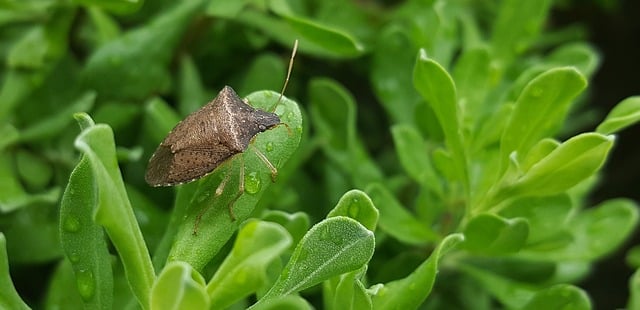Seasonal cues trigger stink bugs to search for winter quarters; the shorter days and falling temps send them looking for cover. Stink bugs don’t look for shelter in mulch or under tree bark, they want in your house for the winter, coming in through cracks and crevices. Researchers once found over 4,000 in a bread box size container and over 30,000 inside an outhouse size building.
Stink Bug Origin
Stink bugs came to the US in the 90’s by getting on shipping containers from China. They are a major crop pest but they don’t sting or bite or pose a health risk. Marmorated Stink Bugs (named for the brown marble pattern on their back) are an annoyance; especially if you smash them and release their stink which is to keep predators away. If they enter your house, they’ll stay there until spring.
Stink Bugs Indoors
Once stink bugs hide indoors, they stage a slow-motion home invasion. They like to explore, so you’ll see them on any surface and they like warmth so you might see them in your shower or splash down into your coffee. When they fly, they bump into things because they’re in a diapause; a sort of insect hibernation. They’re still able to move but not with much finesse.
If there’s a warm-up in temps, they will start flying around your house.
When spring arrives, they’ll head outdoors for food and mating. They’ll only stay in your house for the winter.
Bad news is, if you spot a few, there’s likely an army waiting to march into view….one at a time.
How To Deal With Stink Bugs
Inside, stink bugs tend to congregate on upper walls and in tight places. That’s why they often tuck into drapery folds and walk along the top of walls. They will amass in attics and crawl spaces above garages…so what do you do when you spot a stink bug inside? Here are some suggestions others have used, but we have not yet tried.
Use Essential Oils
Mix 10 drops of mint essential oils with 16 ounces of water and spray interior entry zones.
Neem Oil
This plant-based natural insecticide may take up to a week to work since it interferes with stink bugs instinctual behavior. Combine 32 ounces of water and 2 teaspoons neem oil and spray door frames and window sills
Garlic Spray
Combine 2 cups water and 4 teaspoons of garlic powder and spray on window sills and door frames.
Vacuum
For heavy infestations, you can vacuum the stink bugs but only use a vacuum with a bag so you can seal it and throw it in the outdoor garbage.
Soapy Water
A stink bug’s natural reaction to a threat is to drop straight down. Fill a wide mouth jar with soapy water and add vinegar. Move it under a stink bug and often it will drop right into the liquid and drown. Combine equal parts hot water and dish soap and spray in entryways.
Fly Tape
Strips of fly tape spread on entryways will also catch stink bugs.
Safeguard Your Home
Prevent entry of stink bugs by caulking cracks and crevices where bugs can enter. Place fine mesh over air vents to keep bugs from entering there.
Dryer Sheets
Dryer sheets odor offends stink bugs so rubbing a dryer sheet on window screens and doorways can keep stink bugs out.
Sticky Pads
Cover a dry sweep mophead with a sticky lint remover sheet and use it as a long handled stink bug catcher. It’s perfect for reaching high places.
Chemical Insect Sprays
Few insecticides actually work. The stink bugs exoskeleton is hard and they have long legs and they fly so it’s difficult to get enough product on them to kill them.
Lastly, removal of stink bugs and deterring them from entering your home are the most effective methods for controlling stink bugs.
If you are looking for a locally owned pest control company to help with your pest control needs, please give us a call!
